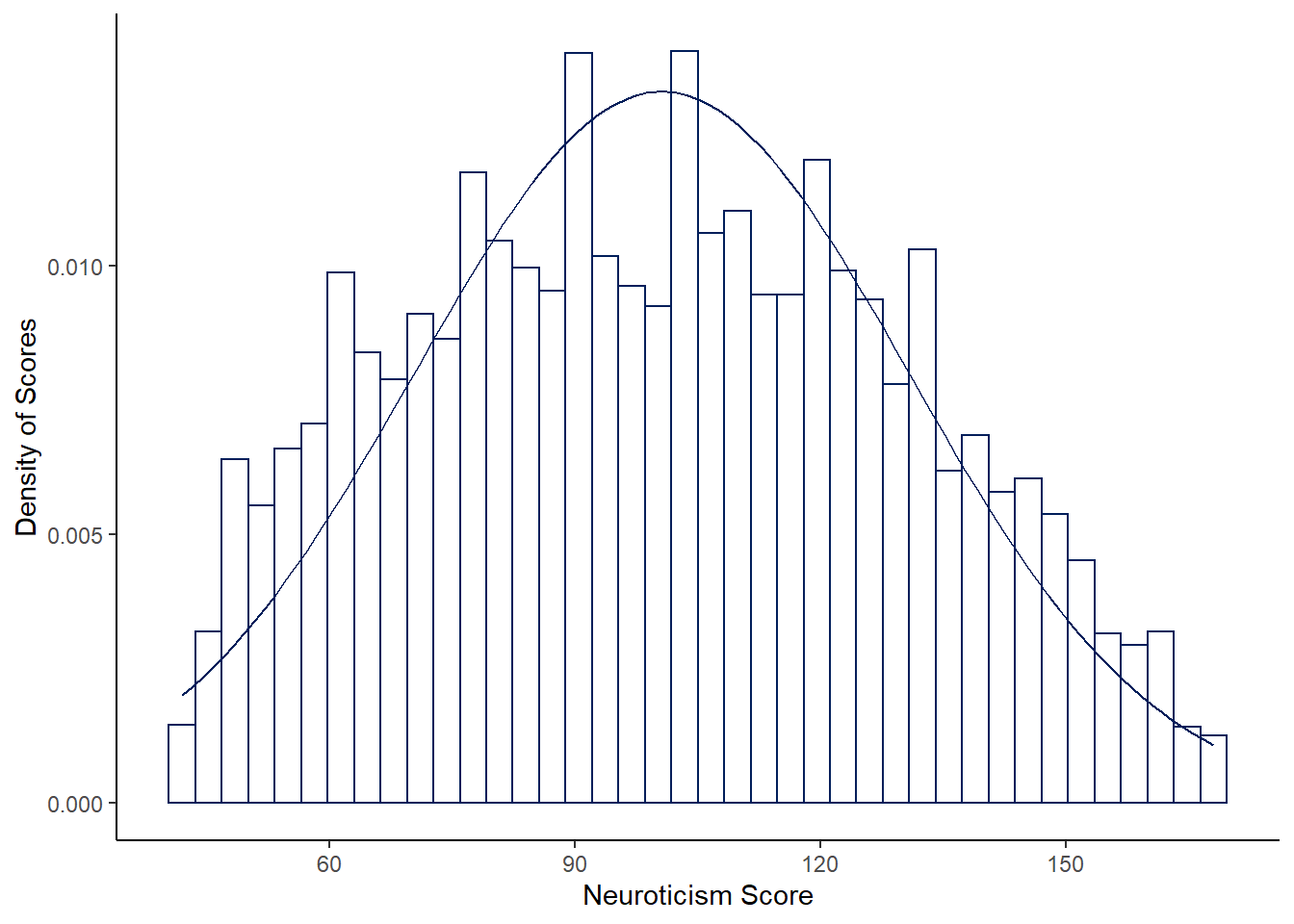Sum specific columns by rows
By Gabriel R. R. in dplyr tutorials function
September 2, 2021
Sometimes you have a messy dataset
By that, I mean a dataset with a messy column ordering, uneccessary variables and so on. That’s somewhat the case with the DASS-42 dataset taken from Kaggle (available here).
I’ve taken the liberty of preserving “only” 10k cases. Let’s load the data and present the problem.
load_libraries <- function(){
if (!require("dplyr"))
install.packages("dplyr"); library(dplyr) # select() and mutate()
if (!require("ggplot2"))
install.packages("ggplot2"); library(ggplot2) # final plot
if (!require("magrittr"))
install.packages("magrittr"); library(magrittr) # %<>% operator
}
load_libraries()
df <- read.csv('https://raw.githubusercontent.com/GabrielReisR/R/master/estrutura%20de%20dados/dados/dass42_brief.csv')[-1]
names(df)
## [1] "X" "Q1A" "Q1I"
## [4] "Q1E" "Q2A" "Q2I"
## [7] "Q2E" "Q3A" "Q3I"
## [10] "Q3E" "Q4A" "Q4I"
## [13] "Q4E" "Q5A" "Q5I"
## [16] "Q5E" "Q6A" "Q6I"
## [19] "Q6E" "Q7A" "Q7I"
## [22] "Q7E" "Q8A" "Q8I"
## [25] "Q8E" "Q9A" "Q9I"
## [28] "Q9E" "Q10A" "Q10I"
## [31] "Q10E" "Q11A" "Q11I"
## [34] "Q11E" "Q12A" "Q12I"
## [37] "Q12E" "Q13A" "Q13I"
## [40] "Q13E" "Q14A" "Q14I"
## [43] "Q14E" "Q15A" "Q15I"
## [46] "Q15E" "Q16A" "Q16I"
## [49] "Q16E" "Q17A" "Q17I"
## [52] "Q17E" "Q18A" "Q18I"
## [55] "Q18E" "Q19A" "Q19I"
## [58] "Q19E" "Q20A" "Q20I"
## [61] "Q20E" "Q21A" "Q21I"
## [64] "Q21E" "Q22A" "Q22I"
## [67] "Q22E" "Q23A" "Q23I"
## [70] "Q23E" "Q24A" "Q24I"
## [73] "Q24E" "Q25A" "Q25I"
## [76] "Q25E" "Q26A" "Q26I"
## [79] "Q26E" "Q27A" "Q27I"
## [82] "Q27E" "Q28A" "Q28I"
## [85] "Q28E" "Q29A" "Q29I"
## [88] "Q29E" "Q30A" "Q30I"
## [91] "Q30E" "Q31A" "Q31I"
## [94] "Q31E" "Q32A" "Q32I"
## [97] "Q32E" "Q33A" "Q33I"
## [100] "Q33E" "Q34A" "Q34I"
## [103] "Q34E" "Q35A" "Q35I"
## [106] "Q35E" "Q36A" "Q36I"
## [109] "Q36E" "Q37A" "Q37I"
## [112] "Q37E" "Q38A" "Q38I"
## [115] "Q38E" "Q39A" "Q39I"
## [118] "Q39E" "Q40A" "Q40I"
## [121] "Q40E" "Q41A" "Q41I"
## [124] "Q41E" "Q42A" "Q42I"
## [127] "Q42E" "country" "source"
## [130] "introelapse" "testelapse" "surveyelapse"
## [133] "TIPI1" "TIPI2" "TIPI3"
## [136] "TIPI4" "TIPI5" "TIPI6"
## [139] "TIPI7" "TIPI8" "TIPI9"
## [142] "TIPI10" "VCL1" "VCL2"
## [145] "VCL3" "VCL4" "VCL5"
## [148] "VCL6" "VCL7" "VCL8"
## [151] "VCL9" "VCL10" "VCL11"
## [154] "VCL12" "VCL13" "VCL14"
## [157] "VCL15" "VCL16" "education"
## [160] "urban" "gender" "engnat"
## [163] "age" "screensize" "uniquenetworklocation"
## [166] "hand" "religion" "orientation"
## [169] "race" "voted" "married"
## [172] "familysize" "major"
The thing here is: item responses are stores in the “Q_number_A” columns. And columns are ordered in a weirdy weird way. The DASS scale measures depression, anxiety and stress. Say we’re interested in joining these three constructs in an umbrella construct called neuroticism.
In order to do that, we’d need to sum all items that start with a Q and ended with an A. We can do that with dplyr.
df %<>%
mutate(neuroticism = df %>% select(starts_with("Q") & ends_with("A")) %>%
rowSums())
What we’ve done is:
- Created a column called neuroticism using the
mutatefunction. - Selected all variables in df that started with “Q” and ended with an “A”.
- Used
rowSums()on those variables and stored it in neuroticism.
Let’s check out our new variable!
df %>%
ggplot(aes(neuroticism)) +
geom_histogram(aes(y = ..density..), bins = 40,
colour = "#011e5a", fill = "white") +
stat_function(fun = dnorm,
args = list(
mean = mean(df$neuroticism, na.rm = T),
sd = sd(df$neuroticism, na.rm = T)),
colour = "#011e5a") +
# Rótulos
xlab('Neuroticism Score') +
ylab('Density of Scores') +
# Tema
theme_classic()

It worked! That’s it for today!